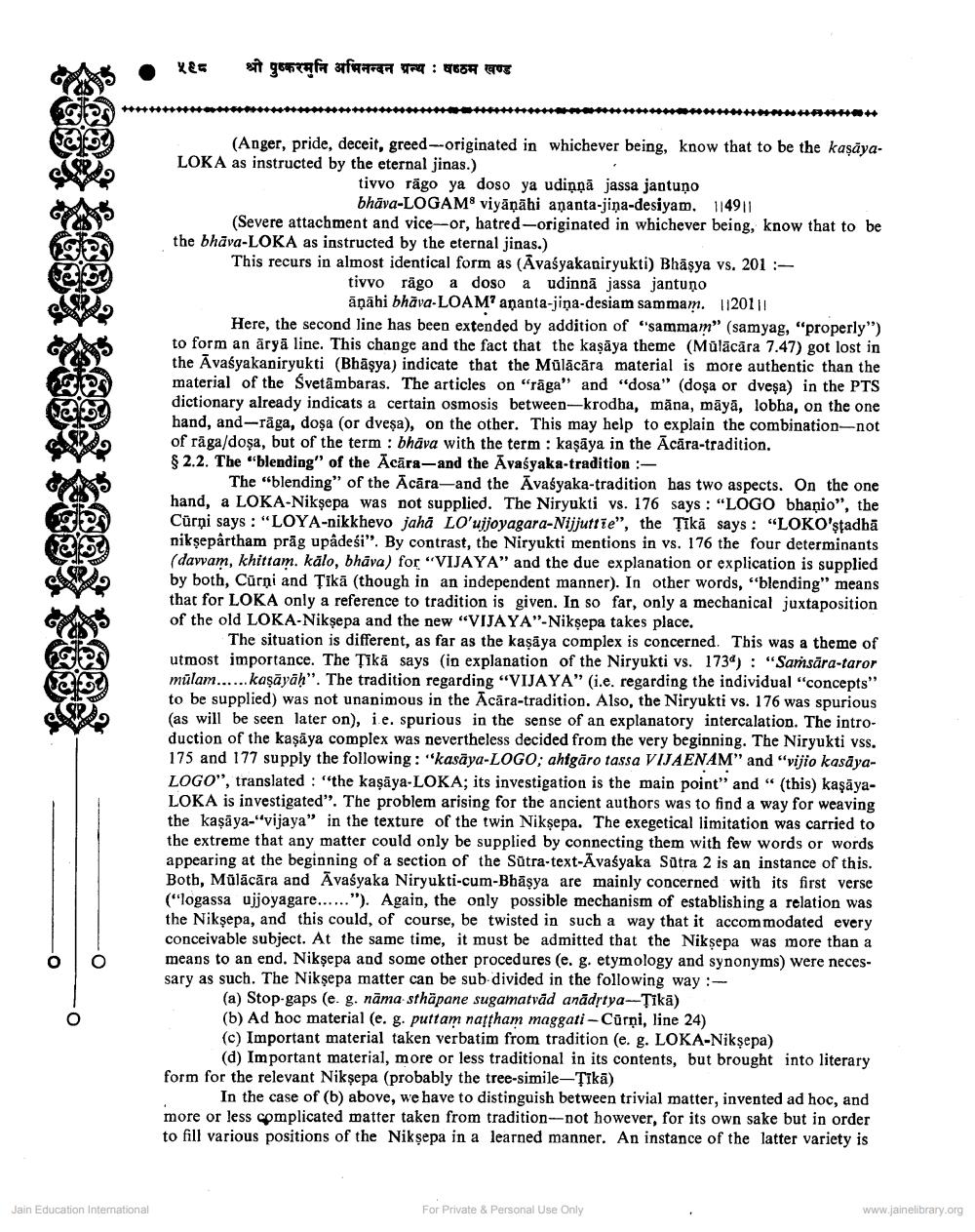Book Title: Logavijaya Niksepa and Lokavicaya Author(s): Bhatt Publisher: Z_Pushkarmuni_Abhinandan_Granth_012012.pdf View full book textPage 3
________________ ५९. श्री पुष्करमुनि अभिनन्दन ग्रन्थ : षष्ठम खण्ड (Anger, pride, deceit, greed--originated in whichever being, know that to be the kaşayaLOKA as instructed by the eternal jinas.) tivvo rägo ya doso ya udiņņā jassa jantuno bhäva-LOGAM viyāņāhi ananta-jiņa-desiyam, 114911 (Severe attachment and vice-or, hatred-originated in whichever being, know that to be the bhāva-LOKA as instructed by the eternal jinas.) This recurs in almost identical form as (Āvaśyakaniryukti) Bhäsya vs. 201 - tivvo rägo a doso a udinna jassa jantuno āņāhi bhāva-LOAM? ananta-jiņa-desiam sammam. 1120111 Here, the second line has been extended by addition of "sammam" (samyag, "properly') to form an äryä line. This change and the fact that the kaşāya theme (Mülācāra 7.47) got lost in the Avaśyakaniryukti (Bhāşya) indicate that the Mülācāra material is more authentic than the material of the Svetāmbaras. The articles on "rāga" and "dosa" (dosa or dveşa) in the PTS dictionary already indicats a certain osmosis between-krodba, māna, māyā, lobha, on the one hand, and-rāga, doşa (or dveşa), on the other. This may help to explain the combination-not of rāga/dosa, but of the term : bhāva with the term : kaşāya in the Ācāra-tradition. $ 2.2. The "blending" of the Acara-and the Avasyaka-tradition : The "blending" of the Ācāra-and the Āvasyaka-tradition has two aspects. On the one hand, a LOKA-Niksepa was not supplied. The Niryukti vs. 176 says: "LOGO bhanio", the Cürni says: "LOYA-nikkhevo jaha LO'ujjoyagara-Nijjuttie", the Tikä says: "LOKO'stadhā niksepârtham präg upadesi". By contrast, the Niryukti mentions in vs. 176 the four determinants (davam, khittam, kālo, bhāva) for "VIJAYA" and the due explanation or explication is supplied by both, Cūrni and Tikā (though in an independent manner). In other words, "blending" means that for LOKA only a reference to tradition is given. In so far, only a mechanical juxtaposition of the old LOKA-Niksepa and the new "VIJAYA"-Niksepa takes place, The situation is different, as far as the kaşāya complex is concerned. This was a theme of utmost importance. The Țīkā says (in explanation of the Niryukti vs. 1734): "Samsāra-taror mūlam...... kaşāyāḥ". The tradition regarding “VIJAYA" (i.e. regarding the individual "concepts" to be supplied) was not unanimous in the Ācāra-tradition. Also, the Niryukti vs. 176 was spurious (as will be seen later on), ie, spurious in the sense of an explanatory intercalation. The introduction of the kaşaya complex was nevertheless decided from the very beginning. The Niryukti vss. 175 and 177 supply the following: "kasāya-LOGO; ahlgāro tassa VIJAENAM" and "vijio kasāyaLOGO", translated : "the kaşaya-LOKA; its investigation is the main point" and "(this) kaşāyaLOKA is investigated". The problem arising for the ancient authors was to find a way for weaving the kaşaya-"vijaya" in the texture of the twin Nikşepa. The exegetical limitation was carried to the extreme that any matter could only be supplied by connecting them with few words or words appearing at the beginning of a section of the Sutra-text-Avaśyaka Sūtra 2 is an instance of this. Both, Mülācāra and Āvaśyaka Niryukti-cum-Bhāşya are mainly concerned with its first verse ("logassa ujjoyagare......"). Again, the only possible mechanism of establishing a relation was the Niksepa, and this could, of course, be twisted in such a way that it accommodated every conceivable subject. At the same time, it must be admitted that the Niksepa was more than a means to an end. Niksepa and some other procedures (e. g. etymology and synonyms) were necessary as such. The Nikşepa matter can be sub-divided in the following way: (a) Stop gaps (e. g. nāma sthāpane sugamatvad anādrtya--Tikā) (b) Ad hoc material (e. g. puttam nattham maggati - Cūrņi, line 24) (c) Important material taken verbatim from tradition (e. g. LOKA-Niksepa) (d) Important material, more or less traditional in its contents, but brought into literary form for the relevant Nikṣepa (probably the tree-simile-Tikā) In the case of (b) above, we have to distinguish between trivial matter, invented ad hoc, and more or less complicated matter taken from tradition--not however, for its own sake but in order to fill various positions of the Niksepa in a learned manner. An instance of the latter variety is Jain Education International For Private & Personal Use Only www.jainelibrary.orgPage Navigation
1 2 3 4 5 6 7 8 9 10
